7 Tips for Buying Used Tractors


Buying used farm and ranch equipment can be more cost-effective than buying new. No matter if a tractor is new or used, you want to be sure the purchase you are making is a solid investment. Add these seven tips to your checklist when reviewing your used tractor purchase to find the perfect used tractor for you.
The first step in buying a used tractor that’s suitable for your needs is to consider what types of tasks you need the tractor to be able to perform, such as hauling, mowing or plowing. When you’ve figured out what you need the tractor to do, you can think about what size tractor you want as well as which accessories or attachments will be necessary.
As you start your search for the right used tractor, you might initially look at listings online. Pay close attention to the photos and prepare any questions you might have for sellers. But before making a commitment to buy, always go see the used tractor in person and get a feel for the condition it’s in.
You may have thought this term was reserved for used car purchases, but many implements offer this designation as well. A certified pre-owned tractor has been thoroughly inspected, and the dealership is willing to certify that all parts are in working order. Dealerships may be able to offer a warranty or include a service guarantee with your purchase. These used tractors are typically newer with fewer working hours under their belt, and they could be a solid option for your ag operation.
When shopping for a used tractor, check out the hours on the tractor. Was it used every day, just during harvest or somewhere in between? The fewer hours it has been used, the more mileage you are likely to get out of it going forward. One rule of thumb is that a reading of 35,000 to 45,000 is a high number of miles on a tractor.
Check the maintenance logs for each tractor. Was it regularly maintained, or is the maintenance history spotty? Look for signs that maintenance has been neglected, which could be an indication of larger problems.
Ask the seller if the tractor was stored. If it was mostly outside, it has been exposed to all types of weather, whereas if it was stored in a garage or shed, it was protected from the elements and is likely in better condition. Take a serious look at the outside — is there visible rust or a touch-up paint job used to cover recent repairs? Are the tires in reasonable condition? Be on the lookout for serious weathering, cuts, cracking and bulging. Are there leaks underneath, indicating cracks or dried seals? Gas, oil and water leaks could result in major repairs down the road. Damaged and frayed wiring will have to be replaced.
In addition to what you can see on a visual inspection, talk to the seller about minor and major repairs. Ask for photos that document repairs. Has the used tractor had a history of downtime, or has it been reliable? These factors don’t automatically spell disaster, but they can alert you to potential issues worth investigating.
Take the tractor for a test drive. It should feel easy and safe to get on and off the tractor. A rickety used tractor that seems like it’s about to tip over is a red flag. The hydraulic lines should not exhibit any signs of cracking. Examine the headlights and dash lights to make sure they’re functioning properly. Also look at the rollover protection structure, seat belt and safety switches. Safety features are an important part of a long-lasting tractor.
The used tractor’s engine should start immediately and show no signs of a rough, vibrating idle or too much smoking from the exhaust. Check the tractor smoke color too. Clear is ideal, while white, blue and black all indicate potential internal issues. Once you’re driving the used tractor, you can ensure firsthand that the steering is tight and the brakes, hydraulic lift, clutch and power take-off are operating smoothly.
Whether you are purchasing your used tractor from a private seller, dealership, auction house or other source, ask around. Look for online reviews and review the seller’s history. Most dealerships and auction houses will have online reviews and plenty of word-of-mouth about their business. Private sellers can be a bit trickier to nail down, so talk to people if you aren’t personally familiar with the seller.
No matter who you purchase a used tractor from, don’t be afraid to ask specific questions about the maintenance history, how the tractor has been used, and how much downtime you could expect. Has the tractor been examined by a dealership? Is there an existing warranty in place? If there is still a warranty, ask for the paperwork with the transfer of ownership.
Finding the right used tractor to add to your fleet is only half the battle. You need to continue ongoing maintenance in order to protect your investment. A small effort on your part can make a big difference in the long run. Consider walking around your tractor every day, looking for cracks or leaks that could lead to larger issues. Check (and top off) fluids, grease crucial components and regularly check the filters. Maintain a tractor maintenance logbook so that you can document major and minor repairs.
When you add a used tractor to your fleet, don’t forget to add coverage on your policy. Your local Farm Bureau agent will be able to answer any questions and ensure you have the coverage you need to keep your operation up and running and help you reduce your overall downtime.